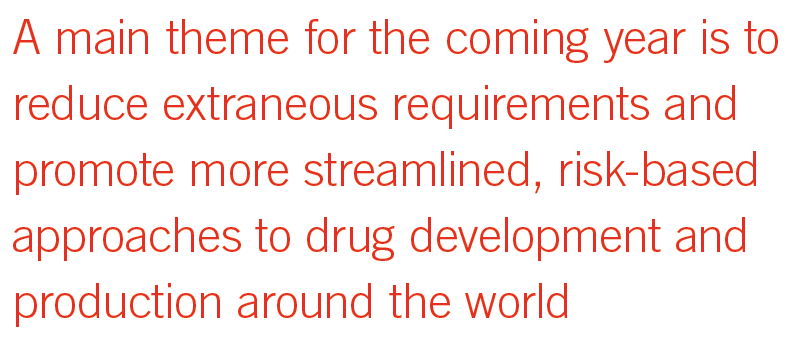Politics & Pricing to Shape Pharma Prospects in 2020
Pharmaceutical Executive
Challenges will mount to established models for researching, developing, and marketing new therapies.
Despite the recent investment boom in biopharma companies, and industry’s continued success in discovering new cutting-edge genomic and cellular therapies, the political environment in Washington will cast a cloud over the prospects for robust R&D and innovative regulatory policies in the coming months. With national elections looming in November, and a host of Democrats vying for the White House, health policy and pharmaceutical
Jill Wechsler

coverage and costs will remain leading issues for the candidates. Politicians on all sides, moreover, will continue to hammer on the role of pharma marketing in fomenting the nation’s devastating opioid epidemic and teen vaping of e-cigarettes, plus the disruptions caused by ongoing shortages of critical medicines.
The future of the Obama administration’s Affordable Care Act hangs in the balance of the debate over federal and state healthcare and drug reimbursement. Pharma will strongly oppose legislation authorizing drug importing and international reference pricing as threats to critical innovation, while also working with plans and payers to devise more value-based payment approaches. But the discovery of additional costly life-saving therapies, including important treatments for more widespread conditions such as sickle cell disease, will require new strategies for ensuring patient access to affordable medicines, along with continued investment in novel science.
Changes at FDA
Important challenges await new FDA Commissioner Dr. Stephen Hahn, who will find it difficult to promote innovative regulatory and policy positions amidst the ongoing opioid and vaping crises. There’s pressure on the agency to clarify its rules for cannabidiol products, particularly dietary supplements promoting health benefits, and to police the rising number of operators claiming cures from untested stem cell and other biological treatments that raise safety as well as legal issues.
Concern about persistent antibiotic resistance also will raise the call for more research on new treatments to combat dangerous infectious diseases.
FDA will continue initiatives for approving more new breakthrough products, including cellular and gene therapies, and to engage with industry R&D programs developing dozens more. Additional agency guidance documents will support these efforts, as will patient advocates that provide important voices for shaping risk-benefit equations for promising treatments. All parties will be watching closely to detect any safety problems or signs of limited effectiveness in new therapies that could raise concerns about long-term benefits and value.
Meanwhile, the public outcry over drug prices will further FDA efforts to streamline and accelerate the approval of more generic drugs and biosimilars as alternatives to expensive brand therapies. While most of the biosimilars approved so far have been slow to reach the market due to complex patent issues as well as innovator efforts to discourage prescribing and coverage of follow-on therapies, analysts predict that a steady rise in new product approvals will begin to have more visible effects on prices. FDA will continue to support ready access to comparators needed for bioequivalence testing, and all parties look to similar versions of insulin products to have a major impact. But the issues are complex, and hurdles will remain in bringing competitive therapies to patients.
Shortages and harmonization
A major source of concern for Congress and healthcare providers will continue to be ongoing shortages of many critical treatments. Increased reliance on drug ingredients imported from China, India, and other countries will continue to put pressure on FDA to better police foreign producers. At the same time, manufacturers will move to boost investment in modern systems able to produce quality, cutting-edge products more reliably and efficiently to assure access to needed drugs.
Global harmonization of standards for drug production and for preclinical and clinical testing will remain an important goal. Innovative agreements between FDA and other regulatory authorities promote sharing and

accepting reports on plant inspections, on certain testing programs, and more recently on information in market applications to achieve simultaneous drug approval decisions in multiple regions. A main theme for the coming year is to reduce extraneous requirements and promote more streamlined, risk-based approaches to drug development and production around the world.
Congress may do more to support these and other R&D initiatives by launching efforts to further policies and programs authorized by the 21st Century Cures Act five years ago. This time the legislators indicate an interest in promoting wider utilization of digital health technologies to improve access to new products and health services; on modernizing coverage policies for innovative, life-saving drugs; and on utilizing real-world evidence more broadly in drug development. The realization of such goals, however, may be caught up in the continuing hostilities in Washington, as the full ramifications of election-year politicking remain to be seen.
Jill Wechsler is Pharmaceutical Executive’s Washington Correspondent. She can be reached at jillwechsler7@gmail.com

Addressing Disparities in Psoriasis Trials: Takeda's Strategies for Inclusivity in Clinical Research
April 14th 2025LaShell Robinson, Head of Global Feasibility and Trial Equity at Takeda, speaks about the company's strategies to engage patients in underrepresented populations in its phase III psoriasis trials.